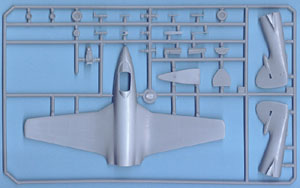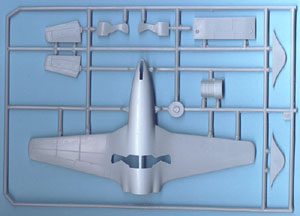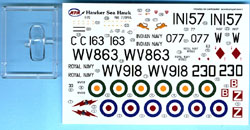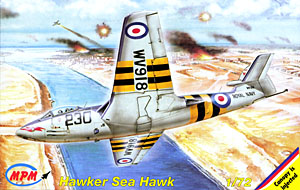MPM's 1/72 Hawker Sea Hawk | | History At the end of the Second World War, everyone was jumping on the jet aircraft bandwagon, with just about every major manufacturer worldwide trying their hand and producing jet-powered fighters. In Britain the RAF already had successful jet fighters with the Gloster Meteor and de Havilland Vampire, but the FAA was slow to adopt the jet engine to its fighter fleet. The lackluster performance from the Supermarine Attacker didn't help matters any, either, but when Hawker entered the ring, its fighter proved to be an excellent entry-level jet for the FAA. Powered by the Rolls Royce Nene engine, the Sea Hawk was a fairly straightforward design, with a straight wing layout and a conventional fuselage. Hawker designers departed from the conventional thinking when it came to the jet exhaust, though. Rather than have the exhaust pipe run the length of the rear fuselage, they split it and had two exhaust pipes exiting at the wing trailing edge. This, combined with the split air intake, greatly increased the internal capacity of the plane, allowing for more fuel capacity and more equipment to be carried internally. This resulted in a cleaner airframe, which helped greatly in performance. The Sea Hawk entered service in the early 1950s and quickly found itself in many FAA squadrons. It saw combat during the Suez Crisis in 1956 and it also ended up in several foreign operators hands, including India, Germany, and the Netherlands.  The Kit The Kit
For a long time the only 1/72 kits of the Hawker Sea Hawk were the old Airfix and Frog examples, both of which weren't exactly detailed. MPM's new kit provides a new-tooled replacement for those older kits, but if you're looking for a highly detailed kit, you're not going to find it here. The kit comes with two gray sprues and one clear sprue. No resin or brass is included. The basic parts breakdown is interesting, but is designed for a future version with the larger tail. The forward fuselage is split into upper and lower halves, the only way to really keep the smooth shapes of the wing-fuselage joint. The rear fuselage is split traditionally into right and left halves. The interior is very basic (although better than the Frog kit). You get a cockpit floor, separate side consoles (nothing more than a couple pieces of bent plastic), a basic instrument panel, simple seat and a control stick. Considering how much can be seen under the rather large bubble canopy, it is disappointing that MPM didn't do more in this area. This all fits into the upper fuselage half, while the lower fuselage half receives a four-piece main gear well made up of a top, front and rear bulkheads, and a piece for the underside of the engine. Two small tailpipes make up the rest of the insides of this kit.  And this is where the largest gripe I have with this kit shows up. There is absolutely nothing provided for the air intakes. In fact, built up out of the box you can see from one air intake through to the other, and the view inside the fuselage is totally unobstructed. In addition to this, MPM completely missed the splitter plate found at the intake root, as well as the splitters found out towards the wingtip on later marks of the Sea Hawk. All three of the decal examples require the latter, so you really can't build this kit out-of-the-box and have it be accurate. And this is where the largest gripe I have with this kit shows up. There is absolutely nothing provided for the air intakes. In fact, built up out of the box you can see from one air intake through to the other, and the view inside the fuselage is totally unobstructed. In addition to this, MPM completely missed the splitter plate found at the intake root, as well as the splitters found out towards the wingtip on later marks of the Sea Hawk. All three of the decal examples require the latter, so you really can't build this kit out-of-the-box and have it be accurate.
The rest of the kit is fairly simple, with the landing gear being basic and requiring the gear doors to be cut apart if you decide to have the gear down. The nose gear bay is actually the underside of the cockpit floor, and there is no effort to blank off the sides like the main gear bay.  The decals are probably the high point of this kit, printed by Cartograf and providing a total of three options. Two are Fleet Air Arm Sea Hawks, the first being an FGA Mk.4 during the Suez Crisis. It's WV918 from 810 NAS off of HMS Albion and is in the standard scheme of Extra Dark Sea Gray over Sky. The yellow and black stripes for Operation Musketeer are painted on the wings and fuselage. The second FAA example is also an FGA Mk. 4, WV863 from 806 NAS, HMS Centaur. Again, it's finished in Extra Dark Sea Gray over Sky. This one features the large ace of diamonds on the forward fuselage. The final example is from the Indian Navy and is an FGA Mk.6, IN157, of 300 Squadron. This example is finished in the Extra Dark Sea Gray over White scheme and features a small tiger on the nose. Unfortunately you'll have to do some spares box scrounging if you decide to do this one, as the roundel colors are reversed. The green should be in the center and the orange on the outer. The decals are probably the high point of this kit, printed by Cartograf and providing a total of three options. Two are Fleet Air Arm Sea Hawks, the first being an FGA Mk.4 during the Suez Crisis. It's WV918 from 810 NAS off of HMS Albion and is in the standard scheme of Extra Dark Sea Gray over Sky. The yellow and black stripes for Operation Musketeer are painted on the wings and fuselage. The second FAA example is also an FGA Mk. 4, WV863 from 806 NAS, HMS Centaur. Again, it's finished in Extra Dark Sea Gray over Sky. This one features the large ace of diamonds on the forward fuselage. The final example is from the Indian Navy and is an FGA Mk.6, IN157, of 300 Squadron. This example is finished in the Extra Dark Sea Gray over White scheme and features a small tiger on the nose. Unfortunately you'll have to do some spares box scrounging if you decide to do this one, as the roundel colors are reversed. The green should be in the center and the orange on the outer.
Conclusion I was really looking forward to this kit. I've wanted to build several Sea Hawks as the colors are interesting, both in FAA hands and with the foreign operators. After seeing this kit, though, I'm not sure that I'll get that collection done with the MPM example. It seems that the only step you've saved with this kit over the Frog or Airfix example is the recessed panel lines. The lack of any intake material will be difficult to overcome, and the simple interior is made even more apparent by the collection of color detail photos on the back of the box. If you already have a Frog or Airfix kit, this kit might not offer anything above those to warrant purchasing it. If you're wanting to build a Sea Hawk, though, and are looking for a kit, this will be a good starting point. Just be prepared for plenty of extra work. | 


 



  
    |

 The Kit
The Kit And this is where the largest gripe I have with this kit shows up. There is absolutely nothing provided for the air intakes. In fact, built up out of the box you can see from one air intake through to the other, and the view inside the fuselage is totally unobstructed. In addition to this, MPM completely missed the splitter plate found at the intake root, as well as the splitters found out towards the wingtip on later marks of the Sea Hawk. All three of the decal examples require the latter, so you really can't build this kit out-of-the-box and have it be accurate.
And this is where the largest gripe I have with this kit shows up. There is absolutely nothing provided for the air intakes. In fact, built up out of the box you can see from one air intake through to the other, and the view inside the fuselage is totally unobstructed. In addition to this, MPM completely missed the splitter plate found at the intake root, as well as the splitters found out towards the wingtip on later marks of the Sea Hawk. All three of the decal examples require the latter, so you really can't build this kit out-of-the-box and have it be accurate. The decals are probably the high point of this kit, printed by Cartograf and providing a total of three options. Two are Fleet Air Arm Sea Hawks, the first being an FGA Mk.4 during the Suez Crisis. It's WV918 from 810 NAS off of HMS Albion and is in the standard scheme of Extra Dark Sea Gray over Sky. The yellow and black stripes for Operation Musketeer are painted on the wings and fuselage. The second FAA example is also an FGA Mk. 4, WV863 from 806 NAS, HMS Centaur. Again, it's finished in Extra Dark Sea Gray over Sky. This one features the large ace of diamonds on the forward fuselage. The final example is from the Indian Navy and is an FGA Mk.6, IN157, of 300 Squadron. This example is finished in the Extra Dark Sea Gray over White scheme and features a small tiger on the nose. Unfortunately you'll have to do some spares box scrounging if you decide to do this one, as the roundel colors are reversed. The green should be in the center and the orange on the outer.
The decals are probably the high point of this kit, printed by Cartograf and providing a total of three options. Two are Fleet Air Arm Sea Hawks, the first being an FGA Mk.4 during the Suez Crisis. It's WV918 from 810 NAS off of HMS Albion and is in the standard scheme of Extra Dark Sea Gray over Sky. The yellow and black stripes for Operation Musketeer are painted on the wings and fuselage. The second FAA example is also an FGA Mk. 4, WV863 from 806 NAS, HMS Centaur. Again, it's finished in Extra Dark Sea Gray over Sky. This one features the large ace of diamonds on the forward fuselage. The final example is from the Indian Navy and is an FGA Mk.6, IN157, of 300 Squadron. This example is finished in the Extra Dark Sea Gray over White scheme and features a small tiger on the nose. Unfortunately you'll have to do some spares box scrounging if you decide to do this one, as the roundel colors are reversed. The green should be in the center and the orange on the outer.






